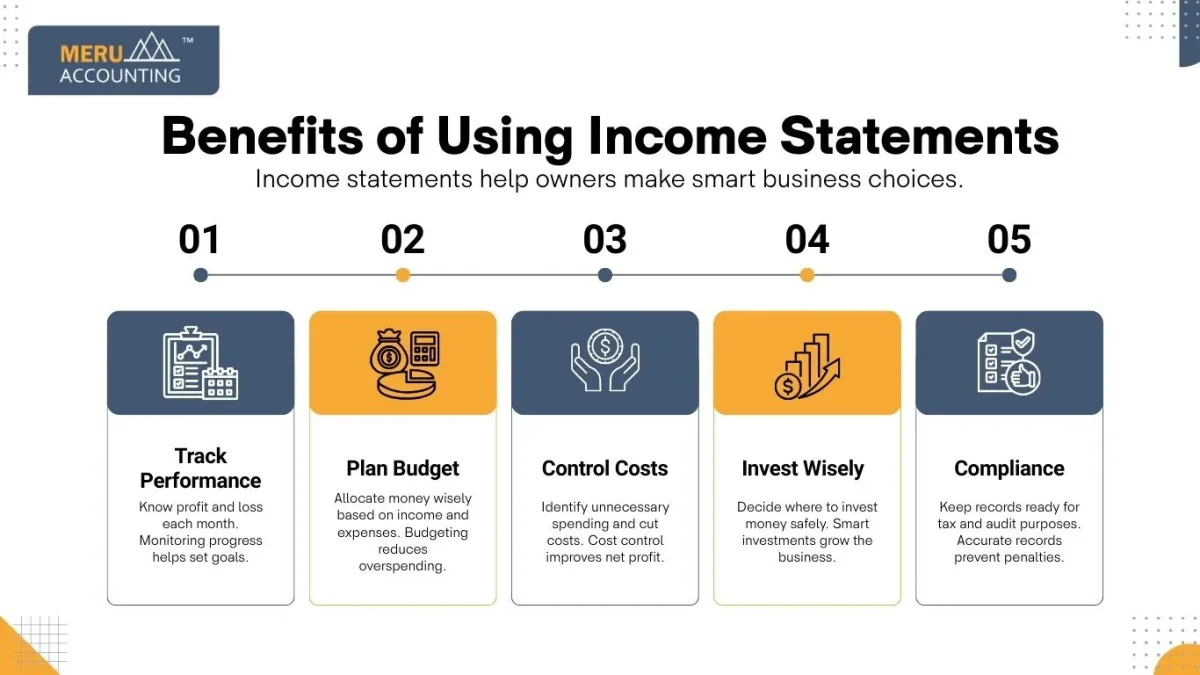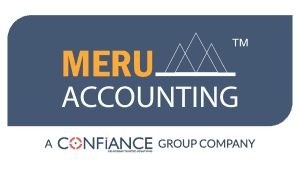Understanding Income Statements to Track Business Performance
Income statements show money in and money out. They help owners see profit, loss, and business health. Every business, big or small, can use them to track growth. Clear income statements make it easy to plan and save. They show which areas make money and which cost too much. Reviewing them often helps spot trends. This makes it simple to set goals and make better decisions. A good income statement gives a clear view of a business’s strength and future.
What Are Income Statements?
Income statements, also called profit and loss statements, show a company’s money flow. They list revenue, expenses, and net profit or loss.
- Revenue: Total money earned from selling products or services. Tracking revenue shows if sales grow.
- Expenses: Costs to run the business daily, like rent, wages, and bills. Keeping track helps control spending.
- Net Profit: Money left after paying all expenses. A positive profit shows the business is healthy.
- Net Loss: When expenses are more than revenue, a loss occurs. Identifying loss areas helps correct mistakes.
Income statements can be done monthly, quarterly, or yearly for regular checks.
Why Income Statements Are Important
Income statements give a clear view of business health.
- Track profits and losses to find trends over time. This helps plan next steps carefully.
- Find high-cost areas and cut unnecessary spending. Cost control improves overall profit.
- Plan budgets for each department and project. Proper planning keeps the business on track.
- Show financial health to banks and investors. Accurate records build trust with lenders.
- Compare business performance with industry standards. Benchmarking helps set realistic goals.
Key Components of Income Statements
Each part of an income statement shows important business information.
1. Revenue or Sales
Revenue is all money earned from sales or services.
- Includes cash and credit sales for complete records. Tracking revenue helps plan sales better.
- Shows which products or services earn the most. This helps focus on profitable items.
2. Cost of Goods Sold (COGS)
COGS is money spent to make products or deliver services.
- Deduct COGS from revenue to find gross profit. This shows how well production works.
- Helps find ways to reduce production costs. Saving here improves overall profit.
3. Gross Profit
Gross profit is revenue minus COGS.
- Shows money available to pay for other costs. Gross profit indicates business efficiency.
- Helps check if prices and costs are balanced. Correct adjustments increase profit over time.
4. Operating Expenses
Operating expenses are costs to run the business daily.
- Includes rent, wages, bills, and supplies. Watching expenses keeps spending under control.
- Helps plan for future costs and reduce waste. Controlled spending improves net profit consistently.
5. Net Profit or Loss
Net profit is money left after all expenses are paid.
- Positive net profit shows growth and a stable business. This helps plan expansion safely.
- Net loss shows problems that need attention fast. Fixing issues prevents long-term damage.
Types of Income Statements
Different formats give different details.
1. Single-Step Income Statement
- Subtract total expenses from total revenue to find net profit. It is simple and easy to use.
- Shows a quick view of business performance. Small businesses often prefer this method.
2. Multi-Step Income Statement
- Separates operating and non-operating activities for detail. Shows gross, operating, and net profit.
- Helps managers make smart choices. Detailed statements give a better understanding of money flow.
How to Read Income Statements
Reading income statements is easy when you focus on the main parts.
- Look at revenue to see if sales rise. Growth shows the business is doing well.
- Check COGS (cost of goods sold) to see if costs are low. Low costs mean more profit.
- Watch operating expenses for waste or high spending. Keeping costs low boosts profit.
- See net profit to know the business’s health. Steady profit shows the business is strong.
- Compare with past months or years to find trends. Past patterns help plan for the future.
Benefits of Using Income Statements
Income statements help owners make smart business choices.
- Track Performance: Know profit and loss each month. Monitoring progress helps set goals.
- Plan Budget: Allocate money wisely based on income and expenses. Budgeting reduces overspending.
- Control Costs: Identify unnecessary spending and cut costs. Cost control improves net profit.
- Invest Wisely: Decide where to invest money safely. Smart investments grow the business.
- Compliance: Keep records ready for tax and audit purposes. Accurate records prevent penalties.

Common Mistakes in Income Statements
Avoid mistakes to get accurate results.
- Missing or wrong revenue entries distort profit numbers. Track every sale carefully.
- Mixing personal and business expenses reduces statement clarity. Keep separate accounts always.
- Ignoring non-cash items like depreciation misleads profit figures. Include all adjustments properly.
- Misclassifying revenue or expenses creates confusion in reports. Correct classification gives clear insight.
- Not updating statements regularly limits knowledge about money flow. Frequent updates improve planning.
Tips to Improve Income Statement Accuracy
Accurate income statements support better business decisions.
- Write down each sale or cost on time. Quick notes keep data right.
- Use accounting tools to track and count money. Tools cut human mistakes.
- Match accounts with bank records often. This stops errors and gaps.
- Keep business and personal costs apart. Clear books make statements right.
- Check statements each month for errors or odd patterns. Regular checks keep the data true.
Income Statements for Business Growth
Income statements do more than track cash.
- Spot top-selling products or services to use resources well. Focusing on best sellers lifts profit.
- Cut costs in weak areas to raise net profit. Saving money keeps the business safe.
- Plan ads and campaigns from sales trends. Smart marketing grows sales fast.
- Check staff or team results tied to profits and costs. Good management brings better results.
- Use data to guide expansion or new projects. Clear numbers lower business risks.
Income Statement vs Balance Sheet
Feature | Income Statement | Balance Sheet |
Purpose | Shows profit or loss over a period | Shows assets, liabilities, and owner’s equity |
Key Components | Revenue, expenses, net profit | Assets, liabilities, and equity |
Timing | Monthly, quarterly, or yearly | Shows the position at a specific date |
Focus | Performance over time | Financial position at a point |
Decision Making | Helps improve profits | Helps check business stability |
How Income Statements Help in Decision-Making
Income statements guide daily business choices clearly.
- Show if it is safe to hire new staff. Extra staff costs must match the money coming in.
- Help decide if buying new tools or machines is safe. Money after costs shows affordability.
- Guide product or service pricing choices. Knowing revenue and costs helps set the right price.
- Show which products to keep or stop selling. Focus shifts to items that make money.
- Help plan ads or promotions. Past sales show which ads may work best.
Using Income Statements to Track Business Trends
Income statements reveal changes over time and show patterns.
- Spot seasonal sales trends. Some months bring more money than others.
- Watch costs to see if they rise over time. Rising costs may need action.
- Track profit for each product or service. Comparing profits shows which items work best.
- Compare the current months with past months. Helps see if the business is growing.
- Check the results of new business ideas. Statements show whether changes help or hurt.
Simple Ways to Check Income Statements
Checking statements helps understand business health fast.
- Percent Check: Show each cost as a part of the total money. Helps find big costs.
- Time Check: Compare numbers over months. Shows if business is improving.
- Ratio Check: Compare profit to sales or costs. Shows how well money is used.
- Break-Even Check: See when money earned covers all costs. Shows the minimum needed to avoid loss.
- Trend Check: Track revenue, costs, and profit over time. Shows patterns clearly.
Common Misconceptions About Income Statements
Some owners do not use income statements well.
- Thinking income statements show cash in the bank. They show earned money, not cash in hand.
- Believing high profit means good cash flow. Payments and timing matter for real cash.
- Using statements alone to judge business value. Need other reports, like the balance sheet too.
- Worrying about small losses. Some losses show the business is investing in growth.
- Thinking that large profits are always safe. Rising costs can hide problems.
Using Income Statements by Type of Business
Statements work for all types of business but show slightly different details.
- Stores: Track sales per product or shop. Helps manage stock and offers.
- Factories: Track cost per product batch. Shows if production is efficient.
- Service Work: Track money per client or project. Helps see which clients earn the most.
- Restaurants: Track food and staff costs. Helps price menu items correctly.
- Tech Firms: Track software sales and service costs. Shows regular income trends.
Using Income Statements with Other Reports
Statements are stronger when used with other reports.
- Balance Sheet: Shows what the business owns and owes. Combined, it shows full health.
- Cash Flow Report: Shows real money moving in and out. Confirms profit turns into cash.
- Budget vs Real Report: Compare the plan to real spending. Shows if the business follows the budget.
- Unpaid Invoice List: Track who owes money. Helps see which sales still need payment.
- Expense List: Breaks down costs in detail. Helps find areas to save money.
Digital Tools to Improve Income Statement Accuracy
Using simple tools can improve accuracy and save time.
- Accounting Software: Calculates numbers and tracks money automatically. Reduces mistakes.
- Spreadsheets: Easy input and month-to-month comparison. Helps see changes quickly.
- Cloud Tools: Access reports from anywhere. Keeps data updated in real time.
- Auto Reports: Generate income statements fast with a few clicks.
- Data Check Tools: Watch trends in money and costs. Helps make smarter choices.
Benefits of Regular Income Statement Review
Looking at statements often improves money control.
- Find problems before they grow bigger. Early action avoids large losses.
- Makes staff aware of costs. Helps control spending in all areas.
- Helps predict future months and years. Shows trends to plan ahead.
- Builds trust with lenders and investors. Clear reports show the business is reliable.
- Sets clear goals for sales and spending. Regular checks show if goals are met.
Income statements are key for every business. They show money in, money out, and profit. Accurate statements help plan budgets, reduce waste, and track growth.
Meru Accounting provides services for both income statements and balance sheets. Businesses get full insight into money flow and financial position.
Our team ensures accuracy, legal compliance, and clear insights. With our services, businesses can save time, prevent mistakes, and plan smart growth. Accurate income statements make financial management easier and support long-term success.
FAQs
- What is an income statement?
It is a report showing revenue, expenses, and profit. - How often should businesses prepare income statements?
Prepare them monthly, quarterly, or yearly for accurate tracking. - Why are income statements important?
They help track money, reduce costs, and plan growth. - What is the difference between gross profit and net profit?
Gross profit is revenue minus COGS; net profit is all expenses. - Can income statements help in getting loans?
Yes, lenders check statements to know the business’s financial health. - Who can prepare an income statement?
Accountants or bookkeeping experts can make accurate statements. - Are income statements required by law?
Yes, they are needed for tax and audit purposes.








